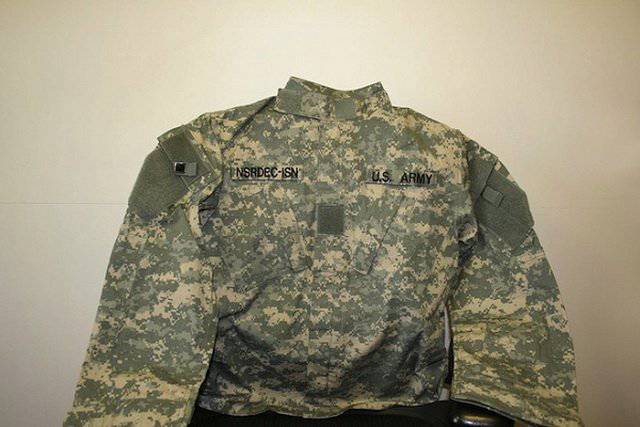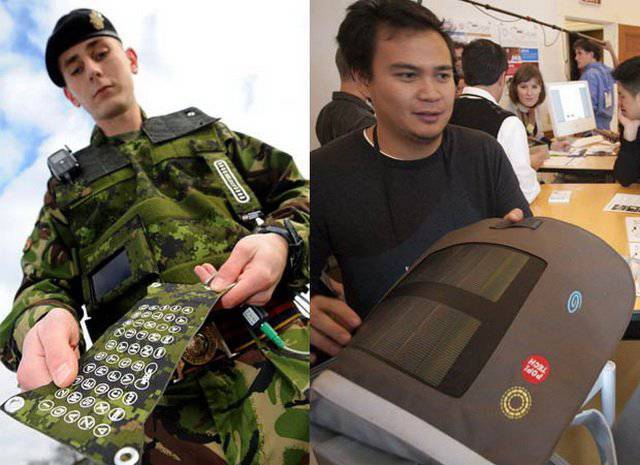The US military is experiencing a "smart" jacket
It is noteworthy that during the opening of ISN, the right to cut the traditional festive ribbon was granted to the American ordinary Jason Ashline, who is a living witness of new technologies on the battlefield (in every sense). In carrying out the combat mission in Afghanistan, in 2001, in a private Jason, an entire AK-47 magazine was discharged, by happy accident and thanks to a modern body armor of ceramic plates, the private soldier retained the most valuable thing - life.
Currently, research conducted by the Institute for Soldier Nanotechnologies is focused on protecting soldiers and officers from the effects of small weapons, explosions, biological or chemical exposure, increasing the combat performance of infantrymen, medical aid and automated control of the physiological state, reducing the weight of the combat display. The institute is working to create a bactericidal and waterproof fabric with a special nano-coating, a liquid that hardens in a magnetic field (for body armor), as well as polymers that could contract in a magnetic field and would be able to perform the role of a medical harness or artificial muscles.
It is worth noting that the discovery of the ISN was quite an important step towards the cooperation of the Massachusetts Institute of Technology (MIT) and the army. Now this cooperation has moved into a fairly new and interesting area - nanotechnology, but MIT has previously collaborated with the US military. During World War II, institute specialists created one of the world's first radars. And already during the “cold war” MIT distinguished himself in the creation of an inertial guidance system for missiles.

Smart Jacket
One of the latest developments of the Massachusetts Institute of Technology has become a field uniform for the military, which is permeated with special gold micronits. With their help, researchers are going to demonstrate to the army that a new uniform can be literally “crammed” with structures that are similar to optical fiber and at the same time can themselves register heat, sound and light. And do it yourself, since these fibers lead directly to transistors, microchips and processors.
According to the head of the Institute of Military Nanotechnology (ISN) John Joannopoulos, these fibers themselves are devices. At present, it is still experimental, rather than a military uniform ready for field use. Now the fibers in it have about a millimeter diameter, but the developers hope to reduce them 10 times, that is, to bring their thickness to 100 microns.
One of the main tasks of these fibers will be to ensure the identification of "friend or foe" on the battlefield. During the conduct of urban battles, as well as at night or in smoke, this task is not so easily solved. At present, the army decides on its use of dense group orders, but what is suitable for dealing with an enemy who is poorly trained in tactical and firing attitudes can become a serious obstacle when meeting with a well-trained tactically and accurately shooting enemy.
The scheme proposed by American developers uses a small laser that is planned to be installed on a soldier’s helmet. When a fighter is irradiated by someone else's form equipped with microfiber sensors, this laser will force them to send a response signal to the fighter. A similar algorithm is planned to be used for speech recognition of soldiers. Thus, in particular, earlier, American soldiers often asked questions about the name of Mickey Mouse’s wife, in order to recognize their own, but given the current globalization, such questions-responses only become partially effective.

The same fibers that are able to recognize heat are intended to be used to determine the location of injuries, as well as their degree of severity. An intelligent jacket can automatically inform medical workers about the need to evacuate a wounded person or to immediately treat him. Used in the form of a wonderful fiber based on a combination of a number of materials that allow you to create an independent microdevice. For example, in order to successfully determine the heat, a special semiconductor material is inserted into the fiber, which dramatically changes its conductivity when heated to a certain temperature.
When creating "smart" fibers, an already tested and developed technology for the production of optical fiber is used, which provides for the execution of the shell and core of various kinds of materials. Currently, the thickness of such fibers is larger than that of a standard fiber optic cable (there are samples with a thickness of 125 µm), since the layers of conductive materials of dielectrics and semiconductors require more space than a conventional sheath and core. In this case, the developers believe that this is only a temporary limitation and over time they will be able to achieve the required thickness of the fibers.
Currently, the "smart" jacket does not have outstanding performance. The communication distance between the fibers is very small. In the manufactured experimental devices it was not possible to achieve a stable connection at a distance of more than 75 meters. In the same case, if there is an obstacle between the soldiers, the process of communication between their uniforms becomes worse.
English smart form design
Nowadays, the equipment of a modern soldier in many armies of the world includes more and more electronic devices, which significantly increase the combat capabilities of fighters. For a number of military units, the use of powerful communication and communication systems, night vision devices, satellite navigation and other similar devices has become familiar. At the same time, numerous batteries and wires create inconveniences for the soldier on the battlefield. However, all these elements may soon become a thing of the past if they can be replaced with a uniform with a special conductive fiber.

Back in 2009, engineers at Intelligent Textiles began to argue that all sorts of sensors and devices reduce the mobility of infantrymen and, together with batteries and wires, form an additional burden on the soldiers. A new military uniform with a conductive fiber integrated into it is designed to save soldiers from this problem. Developed by British engineers, the prototype of the form has its own power source and is a kind of local network to which one or other devices can be connected without any problems. If at present a separate power supply is required to power each device, then it will be possible to connect as many different devices as possible to a single battery through the fabric of a new form.
The conductive fiber, which is woven directly into the fabric itself, aims to reduce not only the physical but also the mental load on the soldiers and officers. Early cable damage often led to the impossibility of using one device or another before the operation was completed, and now the concept of signal redirection along alternative routes has been implemented in a new form. Ashi Thompson, the head of Intelligent Textiles, told reporters that the problem with conventional cable used to be that his gap often became a real disaster. Anticipating this, we tried to build in the form of conductive fiber in excess, in the event that the fabric is torn or damaged, the signal can always be redirected.
In this case, the conductive fiber in a state conducts not only electric current, but also to transmit various data. In the end, this form can be transformed into a “worn-in computer”. Currently, engineers at Intelligent Textiles are working to create a special flexible keyboard on fabric. Tests of the prototype of this form was planned to be completed in May 2012 of the year, so that by the end of the year it could be sent into service with the soldiers of the Royal Air Force (RAF). By the 2014-2015, the UK planned to give this form a massive distribution.
Information sources:
-http: //science.compulenta.ru/737091
-http: //science.compulenta.ru/38881
-http: //www.nanonewsnet.ru/news/2012/britanskie-inzhenery-sozdali-voennuyu-formu-budushchego
Information